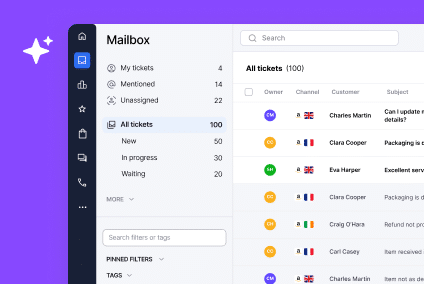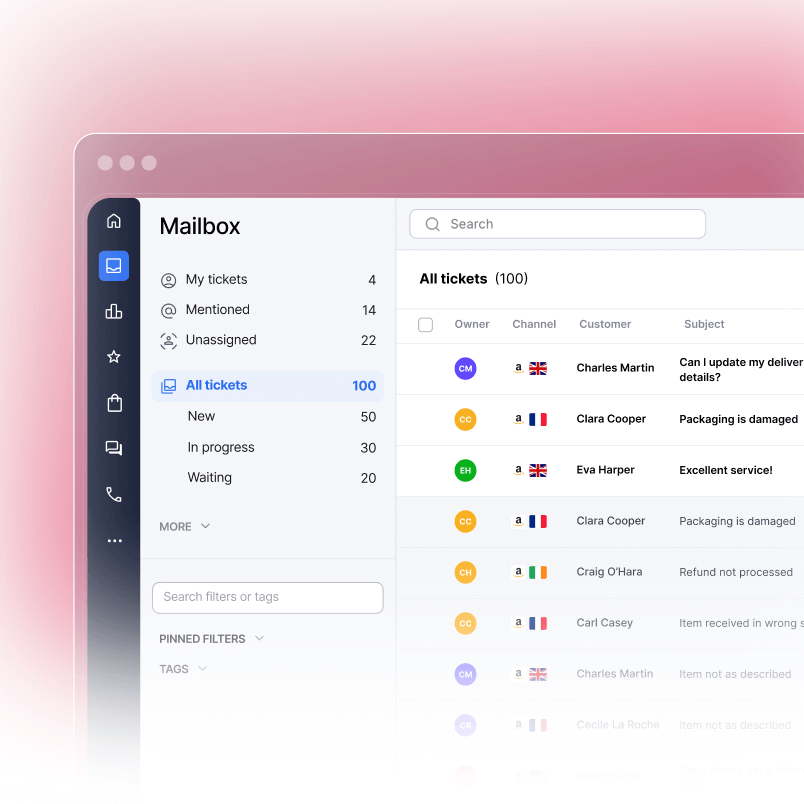AI in ecommerce customer service is moving faster than most teams realize. The chatbot era isn’t dead, but it’s no longer the main event. What’s emerging is something more nuanced: AI that predicts customer problems before they happen, agents who work alongside intelligent assistants, and support that scales across languages without losing the human touch.
If you’re running an ecommerce operation, understanding what’s coming matters. Not just for staying competitive, but for building a support system that actually works for your team and your customers.
Where We Are Now: AI in Ecommerce Support Today
The Current State of AI-Powered Support
Today’s ecommerce support stack includes AI in places you might not notice. Intent detection algorithms read customer messages and route them correctly. Autoresponders send immediate acknowledgments. AI-generated reply suggestions appear in your agent’s inbox. Tickets automatically tag themselves based on content.
This is useful. It reduces response time. It cuts down on repetitive work. According to recent data, companies using AI-powered support tools see a 30-40% reduction in response times compared to teams relying on manual processes alone.
Most of this work happens on three fronts: message classification, reply suggestions, and ticket automation. The infrastructure exists. The workflows are proven. What’s next goes deeper.
What Teams Are Actually Using
Platforms leading this space combine ticketing, live chat, and AI in one interface. Teams use AI to detect when a customer is frustrated or about to churn. They use it to tag tickets for better routing. They use smart macros that adapt based on what a customer wrote.
The teams seeing the best results treat AI as a tool for making support faster and more consistent, not as a replacement for judgment. They set it up once, then iterate based on what works. When choosing a helpdesk, look for advanced CX software with modular AI features that let you control exactly which processes get automated.
Emerging AI Trends That Redefine Customer Support
Predictive Support That Catches Problems Early
Imagine knowing a customer’s order is at risk of being late before they ask. Or flagging that a product has a common defect and reaching out with a solution proactively.
Predictive AI in support works like this: it analyzes patterns across your order data, customer history, and product performance. When it spots risk, it triggers an action. Not a generic email. A targeted message based on exactly what that customer needs.
Use cases include late delivery alerts, churn prediction for at-risk buyers, and automatic detection of product issues based on feedback patterns. A customer who bought three items might be flagged if they return the first one within 48 hours. An order hitting a distribution center with a high failed delivery rate gets flagged automatically.
This shifts support from answering problems to preventing them. The impact is clear: fewer support tickets, higher customer satisfaction, and customers who feel heard before they’re frustrated. Research shows that proactive customer outreach can reduce support volume by 15-25% while improving retention.
Proactive Outreach Triggered by Behavior
Reactive support waits for a customer to reach out. Proactive support reaches out first.
AI-driven triggers are the engine here. A customer lands on your product page but bounces three times. An automated message appears offering help with their specific hesitation. Someone adds an item to cart and abandons it. A gentle nudge appears within minutes, not hours.
During checkout, if a customer’s behavior matches patterns associated with confusion or hesitation, support reaches out in real time. The message is personalized based on which step they’re stuck on. Learn more about how customer service automation can prevent problems before checkout completion.
The key difference from spam: these messages are triggered by actual behavior and timed to the moment someone needs help.
Agent Copilots as Real Teammates
This is where AI stops just assisting and starts collaborating.
An agent copilot sits alongside your support team member in real time. As a customer types, the copilot reads the message, flags the intent, and suggests relevant responses. It summarizes long ticket threads so new agents can jump in without reading everything. It flags when a conversation is escalating and recommends de-escalation language.
The result: agents get smarter faster. Training time drops. Response quality improves. Cognitive load decreases on long shifts when fatigue sets in. Teams using agent assist tools report 20-30% faster ticket resolution times and improved first-contact resolution rates.
Some platforms already offer this. The best ones let agents override suggestions, learn from what works, and build institutional knowledge over time.
True Multilingual Support at Scale
Translation has existed for years. But real-time, nuanced translation in support is newer.
Neural translation powered by modern AI can handle colloquialisms, sarcasm, and context that older tools miss. A customer in Brazil can chat with an agent in the US. The agent sees Portuguese converted to clear English. Their reply comes back in natural Brazilian Portuguese, not stilted automated translation.
This matters for DTC brands going global. It means a small team can support customers across continents without hiring polyglots. Explore how accurate AI translation software supports global operations without expanding headcount.
Voice AI and Conversational IVR
Text-based support is standard. Voice support powered by AI that sounds genuinely human is emerging.
Conversational IVR systems route calls intelligently based on what the caller says, not just keypad inputs. The voice sounds natural because it’s built on neural text-to-speech. The AI understands context and can handle multi-turn conversations without transferring to a human unless needed.
For order status checks, refund tracking, and basic troubleshooting, this works. For complex issues or emotional situations, it knows to hand off quickly.
What AI Still Can’t Handle (And Shouldn’t Try)
AI is powerful, but it has a ceiling. Knowing where that ceiling sits matters.
When a customer is genuinely upset about a failed delivery or defective product, they need a human who understands their frustration. AI-generated sympathy reads as fake. It escalates anger instead of reducing it. A real person who says «I understand this is frustrating, and here’s what we’ll do» changes the dynamic. Learn what actually turns angry customers into happy ones.
Complex product troubleshooting often requires domain knowledge that AI approximates but doesn’t truly possess. If your product is technical or has edge cases, an agent with product expertise beats a chatbot every time.
Return and warranty negotiations are nuanced. What’s fair depends on context. A customer who bought a year ago has different expectations than someone who received a damaged item last week. AI can’t navigate this gray zone the way an experienced agent can.
The lesson is simple: AI augments. Humans retain control. The best support combines both.
Building Your AI-Ready Support Infrastructure
Audit Your Current Processes
Before choosing tools or platforms, map what you’re doing now. Which tickets repeat? Which conversations could be resolved by automation? Where do your agents waste time on repetitive work?
Walk through a typical day of support tickets. Note where AI could help without making things worse. An automated refund eligibility check? Useful. An automated apology to a customer with a legitimate complaint? No.
This audit becomes your roadmap. It shows you where AI has real ROI. Start by looking at your current support volume and identifying which issue types consume the most time.
Choose Platforms with Modular AI
Look for helpdesks and support tools that treat AI as a set of features you can enable or disable, not an all-or-nothing system.
Modular AI means you can turn on intent detection but leave reply generation off. You can use ticket auto-tagging but handle escalations manually. This flexibility lets you experiment without overcommitting. Advanced CX software should give you control over which automation layers activate for your workflow.
Avoid platforms where AI is baked in and can’t be refined or paused. You need control.
Train Your Team to Work With AI, Not Against It
The best AI implementation fails if your team doesn’t trust it.
Bring your support team into the decision. Show them how AI will change their workflow. Let them test it before rollout. Address fears head-on. When they see AI reducing tedious work, not replacing them, buy-in follows.
Set clear SLAs for when AI handles something and when it hands off to a human. If an AI response gets rejected more than 30 percent of the time, that’s a signal to recalibrate.
Platform Innovations to Watch
The Emerging Leaders
Several platforms are moving AI beyond basics. They combine intent detection with smart macro suggestions. They offer agent assist features that summarize threads and flag sentiment shifts. Some now include voice support capabilities.
The platforms doing this best share a common trait: they treat AI as a tool that makes agents better, not as a replacement. They invest in transparency. They let teams see exactly why the AI made a decision. Companies using AI to augment agent capabilities rather than replace them report significantly higher employee satisfaction and stronger business outcomes.
Shopify and Native AI Integration
Shopify has hinted at deeper AI integration in its support tools. The roadmap includes more personalized customer experience flows built directly into the platform. For Shopify stores, this could mean AI that understands order context and product details automatically, without manual setup.
As native integrations mature, they’ll reduce friction. You won’t bolt AI on top of your stack. It’ll be built in.
Ethics, Privacy, and Customer Trust
Transparency in AI-Generated Responses
If your AI generates a customer reply, customers should know. Not in a way that feels like a disclaimer. In a natural way that builds trust, not erodes it.
Some teams note when responses are drafted by AI. Others use AI as a starting point but always add human voice. Both approaches work as long as the intent is honest. According to Forrester’s research on AI transparency and customer trust, 73% of customers prefer knowing when they’re interacting with AI versus being misled about it.
When to Hand Off to Humans
Not every conversation should flow to AI first. Complex issues, emotional situations, and requests requiring judgment should go straight to humans.
Set guardrails. If sentiment analysis flags a frustrated or upset customer, route them to a human immediately. If a ticket matches patterns you’ve flagged as requiring human judgment, skip AI entirely.
Protecting Customer Data
AI systems need data to learn and improve. That data belongs to your customers. Handle it with care.
Ensure your platform complies with privacy regulations. According to research on AI and data privacy, 62% of consumers have concerns about how organizations handle their personal data in AI applications. Understand what data the AI actually needs versus what’s nice to have. Limit data retention. Give customers transparency about how their data is used..
What to Do Right Now
Immediate Steps for Your Team
Start small. Pick one AI feature that solves a specific problem your team faces today. Run it for two weeks. Measure results. Iterate based on what you learn.
Document what works and what doesn’t. Share findings with your team. Build institutional knowledge about your customers and how AI can help them.
Subscribe to updates from platforms you use. The AI landscape is moving fast. What’s not available today might ship next quarter.
Join communities where ecommerce support leaders discuss AI implementations. Real-world feedback from teams in your space matters more than vendor promises.
FAQs
How is AI used in ecommerce customer service today?
AI detects customer intent, suggests agent responses, auto-tags tickets, routes conversations intelligently, and generates initial responses. Most implementations combine these features to speed up response times and reduce repetitive work without fully automating complex issues.
What’s the difference between AI and automation in support?
Automation follows fixed rules set by humans. AI learns from data and adapts. An automation sends a response when a customer types specific keywords. AI reads the intent behind the message and routes it to the right solution, even if the wording varies.
Can AI fully replace support agents?
Not without damaging your business. AI handles straightforward questions and repetitive tasks well. It struggles with emotionally charged situations, complex troubleshooting, and nuanced decisions. The best teams use AI to make agents faster and smarter, not to eliminate them.
What are the most promising AI tools for DTC brands right now?
Platforms combining ticketing, live chat, and native AI features are leading. Look for tools that offer intent detection, agent assist features, predictive analytics, and modular AI you can enable or disable based on your needs. Test before committing.
How do I know if my team is ready for AI-powered support?
Readiness isn’t technical. It’s about having documented processes, buy-in from your support team, clear metrics for success, and a willingness to iterate. If your team currently handles tickets manually with some inconsistency, that’s actually a good starting point. AI thrives where processes need standardizing.




